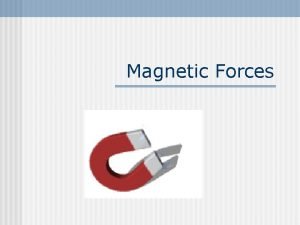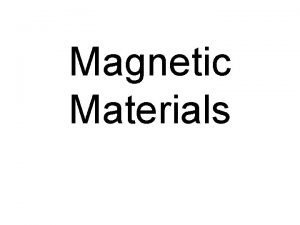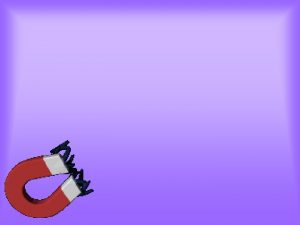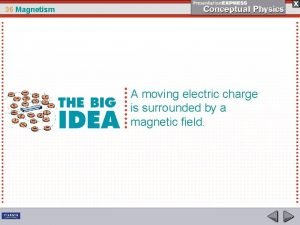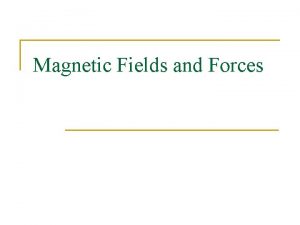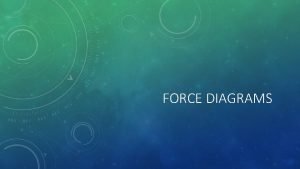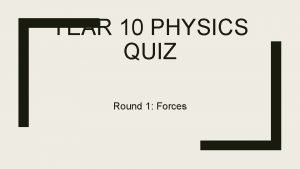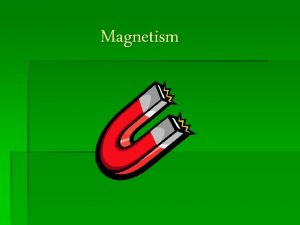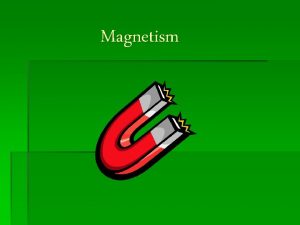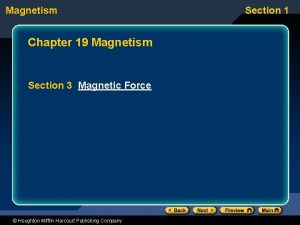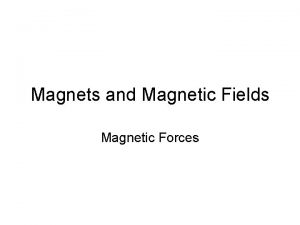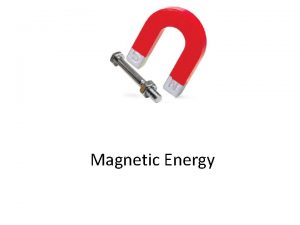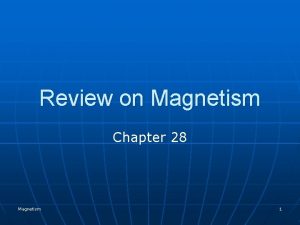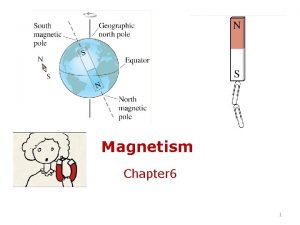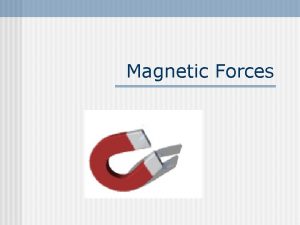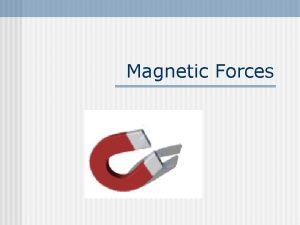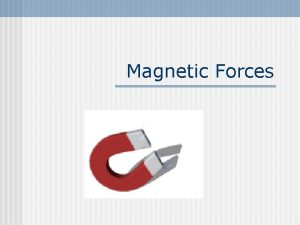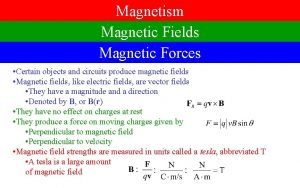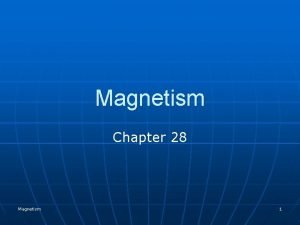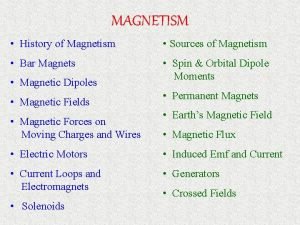Chapter 21 Magnetism A Magnetic Forces Magnetic force




















- Slides: 20

Chapter 21 Magnetism

A. Magnetic Forces • Magnetic force is the force a magnet exerts on another magnet, on iron or a similar metal, or on moving charges. • Magnetic force is one aspect of electromagnetic force • Magnetic (like electric forces) act over a distance and is stronger at a closer distance. • Magnetic poles are the regions where the magnet’s force is strongest, one is the north pole and one is the south pole. • Like magnetic poles repel one another, and opposite magnetic poles attract one another

B. Magnetic Fields • Magnetic field surrounds a magnet and can exert magnetic forces. • A magnetic field, which is strongest near the poles, will either attract or repel another magnet that enters the field. • The field near begin near the north pole and end at the south pole.

1. Magnetic Fields around Magnets • Using iron filings will help see how magnetic fields interact. • Magnetic field surrounds every magnet, the 1 st picture shows how they start and end at the poles • 2 nd picture shows how two similar magnets repeal each other, notice the field lines push away from each other. • 3 rd picture show two opposite magnet poles attract each other, notice that the field lines line up.

Magnetic Field Around Earth • Earth is like a giant magnet surround by a magnetic field • Magnetosphere is the area surrounding Earth that is influenced by this field • Compass points north because it aligns with earth’s magnetic field • Magnetic declination is the angle between the direction to true north and to magnetic north

C. Magnetic Materials • Electrons move around the nucleus, and the spin of each electron causes it to act like tiny magnets. • In many materials the electrons is paired with another and the magnetic effects mostly cancel each other • Other materials have one or more unpaired electron and this unpaired electron produces magnetic fields • In few materials the unpaired electrons make a strong magnetic field (iron, nickel, cobalt) • Magnetic domain is a region that has a very large number of atoms with aligned magnetic fields • Ferromagnetic material can be magnetized because it contains magnetic domains • When a material is magnetized most of its magnetic domains are aligned.

1. Nonmagnetized Materials • A material that is ferromagnetic does not mean it is a magnet • If the domains of the material are aligned randomly then the magnetization of the domains is canceled

2. Magnetized Materials • You can magnetize a nonmagnetized ferromagnetic material by placing it in a magnetic field • Image above show the alignment of magnetic domains in magnetized iron. • In some materials the domains say aligned for a long time, these are called permanent magnets • Heat or a jarring impact can realign the domains in a permanent magnet • If you cut a magnet in ½ it will still have a north and south pole • A magnet can never have just a north pole or just a south pole

2. Magnetized Materials

21. 2 Electromagnetism • Unlike electric charges attract one another and like electric chares repel one another • Unlike poles attract one another and like poles repel one another A. Electricity and Magnetism • Electromagnetic force is the force associated with charged particles, which has two aspects electric force and magnetic force. • Electric force results from charged particles • Magnet force usually results from the movement of electrons in an atom

1. Magnetic Fields around moving charges • Moving electric charges create a magnetic field • The charges may be vibrating charges that produce electromagnetic waves or may be moving charges in a wire • Magnetic field lines form circles around a straight wire carrying a current. • Point thumb of right hand in direction of current, your fingers curve in the direction of the magnetic field


2. Forces Acting on Moving Charges • Recall electric field exerts a force on an electric charge • The force is either in the same direction as the electric field or in the opposite direction (depending on charge) • A charge moving in a magnetic field will be deflected in a direction perpendicular to both the magnetic field and the velocity of the charge • If a current carrying wire is in a magnetic field the wire will be pushed in a direction perpendicular t both the field and the direction of the current.

3. Solenoids and Electromagnets • If you loop a current carrying wire many times to make a coil the magnetic fields of the lops combine so that the coiled wires acts like a bar magnets • Solenoid is a coil of current carrying wire that produces a magnetic field • If you place a ferromagnetic material (iron rod or nail) the strength of the magnetic field increases. • Electromagnetic is a solenoid with a ferromagnetic core • Changing the current in an electromagnet controls the strength and direction of its magnetic field

3. Solenoids and Electromagnets • Hair dryers, telephones, and doorbells utilize electromagnetic • The strength of an electromagnetic depends on the current in the solenoid, number of loops in the coil and the type of ferromagnetic core. • greater current produces a stronger magnetic field • Increases the number of turns while keeping the current the same will increase the field strength • Cores that are easily magnetized make stronger electromagnets

B. Electromagnetic Devices • Electromagnets can convert electrical energy into motion that can do work • Electromagnetic devices such as galvanometers, electric motors, and loudspeakers change electrical energy into mechanical energy.

1. Galvanometer • Galvanometer a device that uses a solenoid to measure small amounts of current. • When there is a current in the solenoid • S coils the magnetic field attempts to align with the field of the permanent magnets • A fuel gauge is an example of a galvanometer

2. Electric Motors • Electric motor is a device that uses and electromagnet to turn an axle • A battery supplies current to a loop of wire through the commentator • At the commentator turns the direction d of current switch back and forth • The coil’s magnetic field keeps switch direction and this turns the coil about an axle • For each ½ rotation of the wire loop, the current produced by the generator reverses direction or alternate

Electric Motor

3. Loudspeakers • A loudspeaker contains a solenoid places around one pole of a permanent magnet • The current in the wires entering the loudspeaker changes direction and increases or decreases to reproduce music, voices or other sounds • The changes current produces a changes magnetic field in the solenoid coil • magnetic forces cause motion that produce sound waves
 Conceptual physics magnetism
Conceptual physics magnetism Force on charged particle
Force on charged particle N= what
N= what Magnetic flux units
Magnetic flux units It is an invisible force
It is an invisible force Chapter 36 magnetism answer key
Chapter 36 magnetism answer key Unlike parallel force
Unlike parallel force The forces shown above are
The forces shown above are Intermolecular vs intramolecular
Intermolecular vs intramolecular Intermolecular forces vs intramolecular forces
Intermolecular forces vs intramolecular forces Intramolecular forces vs intermolecular forces
Intramolecular forces vs intermolecular forces Contact vs noncontact forces
Contact vs noncontact forces Unbalanced force
Unbalanced force Erosion is a destructive force that
Erosion is a destructive force that Learning: module 26: magnetic forces and fields
Learning: module 26: magnetic forces and fields Trivia about magnetism
Trivia about magnetism Magnetic retentivity
Magnetic retentivity Weber unit
Weber unit Magnetic moment and magnetic field relation
Magnetic moment and magnetic field relation Physics free body diagram
Physics free body diagram Which of the following forces is a contact force? *
Which of the following forces is a contact force? *


